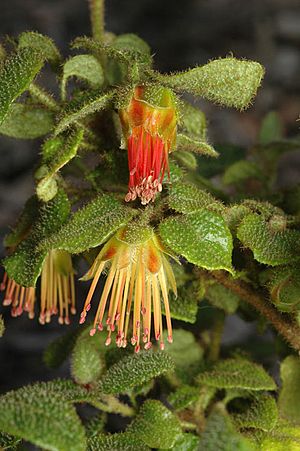Diplolaena andrewsii facts for kids
Quick facts for kids Diplolaena andrewsii |
|
|---|---|
 |
|
| In Kings Park, Perth | |
| Scientific classification | |
| Kingdom: | |
| (unranked): | |
| (unranked): | |
| (unranked): | |
| Order: | |
| Family: | |
| Genus: |
Diplolaena
|
| Species: |
D. andrewsii
|
| Binomial name | |
| Diplolaena andrewsii Ostenf.
|
|
Diplolaena andrewsii is a special flowering plant. It belongs to the Rutaceae family, which also includes citrus fruits. This plant is found only on the west coast of Western Australia. It's a unique part of Australia's natural world.
What Does Diplolaena andrewsii Look Like?
This plant is a wide, bushy shrub. It can grow up to about 1 meter (3 feet) tall. Its leaves are shaped like hearts or eggs. They are about 1.5 to 4 centimeters (0.6 to 1.6 inches) long. The leaves feel a bit rough. This is because they have tiny, star-shaped hairs on both sides. They grow on a small stalk called a petiole, which is about 4 to 10 millimeters long.
The flowers grow in round bunches. Each bunch can be up to 1.5 centimeters (0.6 inches) wide. These flower bunches have special leaf-like parts around them. These parts are called bracts. The outer bracts are green and rounded. They are about 8 millimeters long. They also have those tiny star-shaped hairs.
The inner bracts are a bit longer. They are reddish-brown with white edges. Inside, the petals are about the same length as the inner bracts. The plant has long parts called stamens. These stamens are 10 to 14 millimeters long. They have light red hairs on their lower half. You can usually see this plant flowering from July to September.
How Was This Plant Discovered and Named?
The Diplolaena andrewsii plant was first officially described in 1921. A scientist named Carl Hansen Ostenfeld wrote about it. His description was published in a science journal. This journal was called Biologiske Meddelelser. It is from The Royal Danish Academy of Sciences and Letters.
Where Does Diplolaena andrewsii Grow?
This plant is found in the Darling Range near Perth, Western Australia. It likes to grow among granite rocks. You can often see it in woodland areas there.

